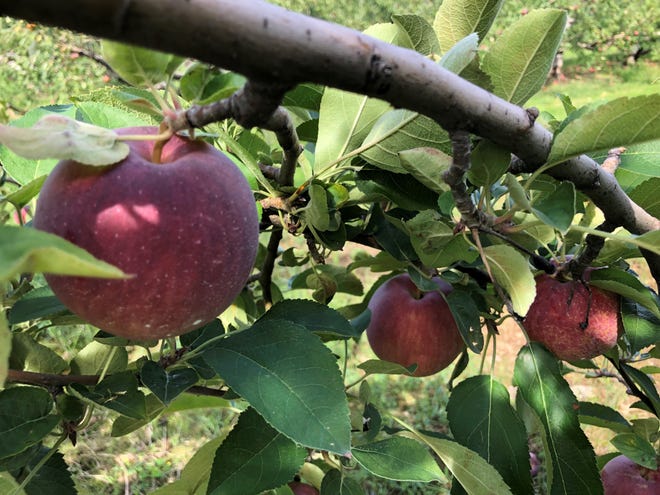Garden: Want to grow apple trees? Here are ideal times to plant and varieties to consider

The warm weather we've experienced in Greater Columbus this past week has many a gardener itching to get outside and plant something. This past week I saw the first fruit trees available for purchase in local garden centers and it reminded me that March and April are the perfect time to plant fruit trees, especially apple trees. There are many reasons why a gardener might choose to plant a few apple trees in the home landscape, but the most compelling reason is probably the ability to grow varieties of apples that are not readily available at the grocery store.
Many varieties of apples are available as both container-grown stock or as bare-root whips, which are one-year-old single-stem trees without any side branches. Hundreds of different apple varieties are available for purchase from nurseries online as bare-root whips. Apple trees can also be purchased from local nurseries or garden centers as container-grown trees. However, a much larger selection of apple varieties is available as bare-root whips.
Consider size
Home apple growers should grow either dwarf or semi-dwarf trees instead of standard or full-size trees. Dwarf and semi-dwarf trees are easier to manage, and they produce fruit quicker than standard-size trees. Dwarf apple trees will grow to be about 10 feet tall. Semi-dwarf apple trees will reach about 15 feet in height, while standard-size trees will be at least 20 feet tall. Standard size trees are typically too large for home growers to manage and may grow to be too large for some locations in the home landscape.
Apple varieties are grafted onto rootstocks of different varieties, so many apple varieties are available in dwarf, semi-dwarf and standard sizes because it is mainly the rootstock that determines the tree size.
Site selection
Apple trees need full sun for proper growth and quality fruit production. Early morning sun is particularly important because it dries moisture from dew or rainfall from the leaves, thereby reducing the incidence of foliar diseases. Apple planting sites should be less susceptible to late spring frosts and have good air circulation to reduce the incidence of foliar diseases.

Apple trees grow well in a wide range of soil types. They prefer soils with a texture of sandy loam to a sandy clay loam. Good soil drainage is critical for successful apple production, so avoid locations in the home landscape where surface water accumulates after a rainfall. The ideal soil pH for apple trees is near 6.5, which is acidic, so locations in Greater Columbus with higher pH levels of native soils may need to be amended with sulfur or peat moss in order to lower pH.
Variety selection
When selecting apple cultivars for a home apple orchard, one must consider fruit size, taste, color, bloom period, ripening season, disease resistance and pollen compatibility, all of which are important factors. Home apple growers should consider varieties that are resistant to important diseases such as apple scab, fire blight and cedar apple rust. Some common disease-resistant varieties include Goldrush, Jonafree, Liberty, Pristine, Redfree and Williams’ Pride. A more extensive list of disease-resistant apple varieties suggested for home orchards in Ohio are available at go.osu.edu/homeappleorchard.
Apple varieties that are not disease resistant can be successfully grown in home orchards if an effective disease-management program is followed. This generally requires the frequent use of fungicides. It is important to consider the amount of work and time that will be needed to repeatedly apply pesticides such as fungicide before selecting an apple variety that is non-disease-resistant.
Plant more than one tree
All apple varieties are self-incompatible, meaning that
they cannot pollinate themselves or any flowers of the same variety. You will need to plant at least two different varieties of apple trees in your landscape in order to achieve maximum fruit yield and quality. In addition, the two varieties selected need to have viable pollen and bloom at the same time to ensure successful pollination. Some nurseries also offer apple trees that have two or more compatible cultivars grafted on the same tree, eliminating the need for more than one tree for successful pollination.
Expect insects
It can be very difficult to grow apples in Ohio without the use of some pesticides if the goal is to harvest apples without any damage from pests. While disease-resistant varieties are available, these varieties are still susceptible to insect damage common on apple trees grown in Ohio. Some of the common insects and mites that attack apples are apple maggot, codling moth, plum curculio, San Jose Scale, European red mite and aphids.
In addition to pest control, yearly pruning will be required in order to maintain productivity, but planting a few apple trees in the home landscape can provide a late summer or early autumn harvest of these crispy treats for years to come.
Mike Hogan is Extension Educator, Agriculture and Natural Resources and associate professor with Ohio State University Extension. hogan.1@osu.edu